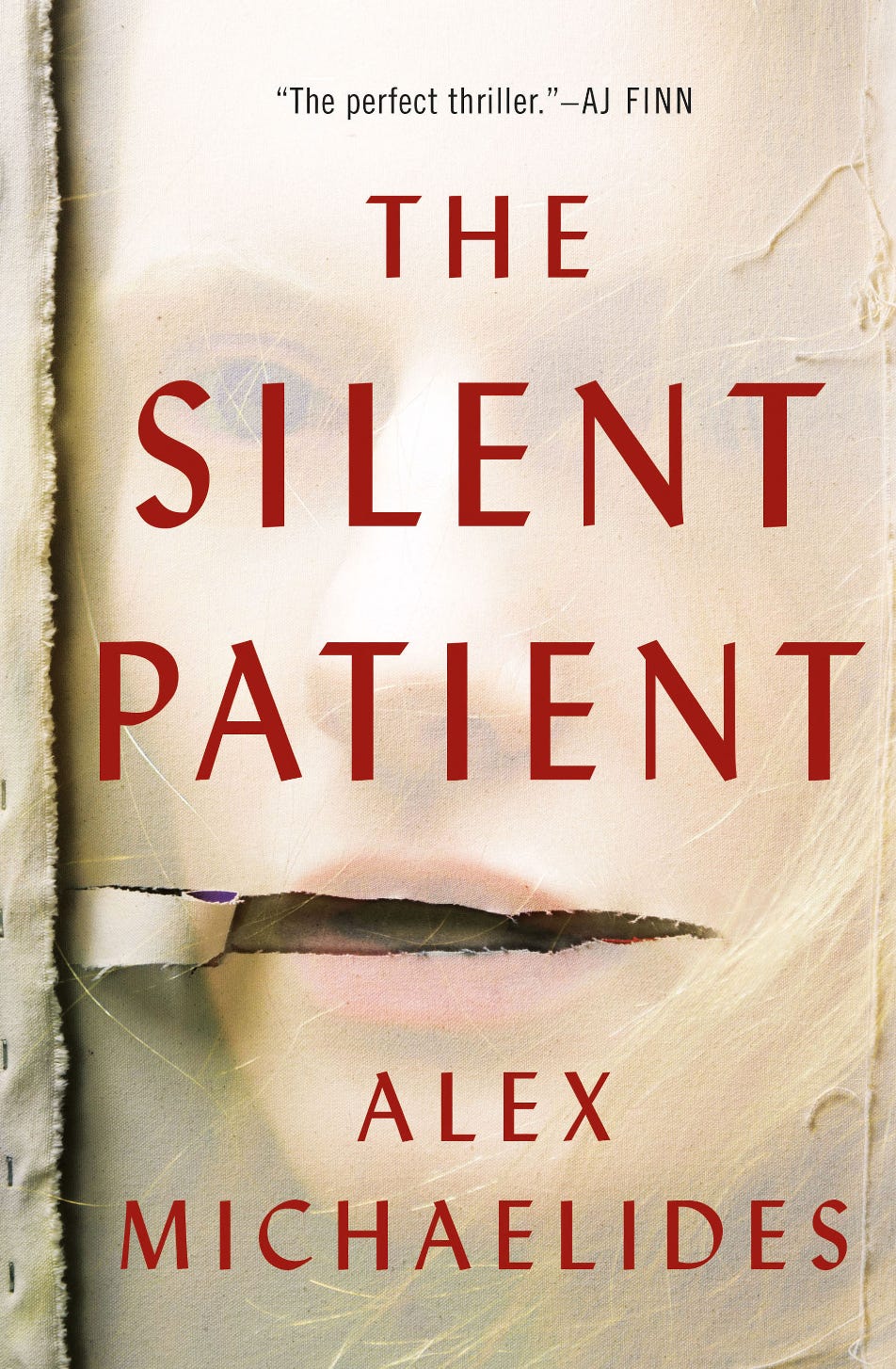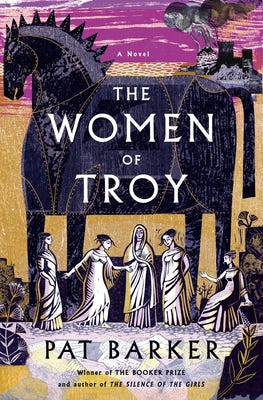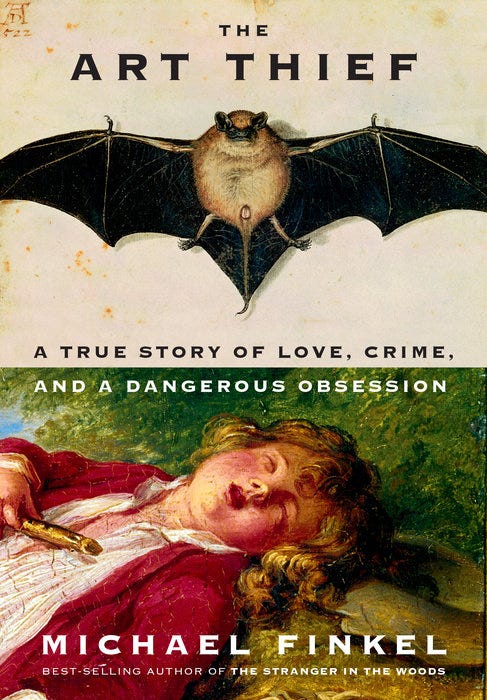Happy Friday — here’s my weekly roundup!
The Silent Patient by Alex Michaelides
I was in the mood for a thriller this week, so I finally picked up The Silent Patient from the library. Set in England, the book centers on Alicia, a famous painter, who shoots her husband, Gabriel (a fashion photographer), five times in the face for apparently no reason. The media can’t get enough of the case. Alicia completes a final painting of Alcestis (from Greek mythology) but otherwise stops speaking. She is sent to a high-security criminal facility and doesn’t speak for six years. Her therapist (Theo, the primary narrator) takes a job at the facility and is convinced he can get Alicia to speak. Michaelides follows Theo’s journey to unravel the case and help Alicia. I devoured this book in a day, but I’m not sure the final twist lives up to the hype.
Rating: 3.8/5
Genres: Thriller - Psychological
Movie/TV Pairings: The Undoing; Gone Girl
Audio: This book would work on audio; it has a good British narrator (8 hr 33 min).
The Women of Troy by Pat Barker
After finishing The Silence of the Girls last week, I turned to The Women of Troy (the next book in Barker’s Women of Troy series). This book is a retelling of Euripides’s tragedy, The Trojan Women. Barker recounts the aftermath of the Trojan War — again, primarily through the perspective of Briseis (a Trojan queen taken captive by Achilles during the war). The Trojan women are divvied out as property to Greek fighters — Trojan Queen Hecuba goes to Odysseus; Hector’s widow Andromache goes to Achilles’ son Pyrrhus; and Hecuba’s daughter Cassandra goes to Agamemnon. Briseis is no longer a slave; she is now married to Alcimus, a powerful Greek. But her marriage is a different type of confinement and servitude.
I really enjoyed this book overall, but I liked it less than The Silence of the Girls. While Briseis takes us deeper into the Greek camps, there is a lot less going on plot-wise. Having upset the gods, the Greeks are stuck on the Trojan beach, unable to sail in the current weather. The Trojan women agonize over the Greek decree not to bury Priam’s body (here, Barker weaves in a retelling of Antigone). This book was also a bit repetitive for me, given that I just read The Silence of the Girls last week (she repeats a lot from it).
Rating: 3.6/5
Genres: Fiction - Myth Retelling
Audio: This book would definitely work on audio if you like a British narrator (12 hr 17 min).
Piglet by Lottie Hazell
Piglet follows a woman (called Piglet, a family nickname) in her early 30s who lives in Oxford, England, with her fiancé, Kit. Piglet is a cookbook editor who prepares elaborate meals for her family and friends. Hazell takes us through the weeks leading up to her wedding. Piglet learns an awful truth about her fiancé and feels trapped and hungry. For her wedding cake, she decides to make croquembouche, which is extremely complicated to bake from scratch and must be prepared and eaten in the same day.
The food and cooking descriptions were my favorite part of this book — the “silky pasta,” the couscous “[s]tudded with shards of pistachio and pomegranate seeds,” the “potatoes, boiled and dotted with a bright salsa verde,” and the bread served with “two types of butter: confit garlic and parmesan and black pepper.” While I enjoyed this book, I have read better prose about food (I’m thinking about Deborah Levy’s Hot Milk) and better explorations of class anxiety (Paul Murray’s The Bee Sting). But I still really enjoyed this!
Rating: 3.6/5
Genres: Contemporary Fiction - Messy Women (Eating)
Movie/TV pairings: Fleabag
The Art Thief by Michael Finkel
The Art Thief tells a stranger-than-fiction true story. Finkel recounts the heists of Stéphane Breitwieser and his then-girlfriend, Anne-Catherine Kleinklaus. Breitwieser and Kleinklaus stole more than 300 famous artworks (estimated at around $2 billion) from European museums and historic sites. The two didn’t steal art to resell it — they wanted to surround themselves with beauty. As Breitwieser said, “Art is my drug.” I love how Finkel explores their obsession — the paintings had a “bubbly effect on both of them, aesthetic champagne.”
Finkel also includes stories of famous art heists, such as Edvard Munch’s The Scream (stolen during the 1994 Winter Olympics in Norway) and the Mona Lisa (stolen in 1911). Interestingly, the going rate for stolen works is only 3-10% of its retail value. The better known the work, the less it goes for on the black market. However, stolen art can be used like currency in the criminal underworld, as it’s more portable than suitcases of cash. Russian intelligence officers have identified more than 40 organized crime groups that accept art as collateral.
This book was an easy read (it’s just over 200 pages) and definitely worth it!
Rating: 3.9/5
Genres: Nonfiction
Movie/TV pairings: The Thomas Crown Affair; Ocean’s Twelve
Articles I couldn’t stop thinking about: This Guardian article about the people fighting to save art in Ukraine.
This Ringer article on Olympic hurdler Sydney McLaughlin.
What I’m cooking: I’ve been cooking recipes by J. Kenji López-Alt this week! These potatoes are game-changing.









